 PathScribe Panel Flyout Menu
PathScribe Panel Flyout Menu
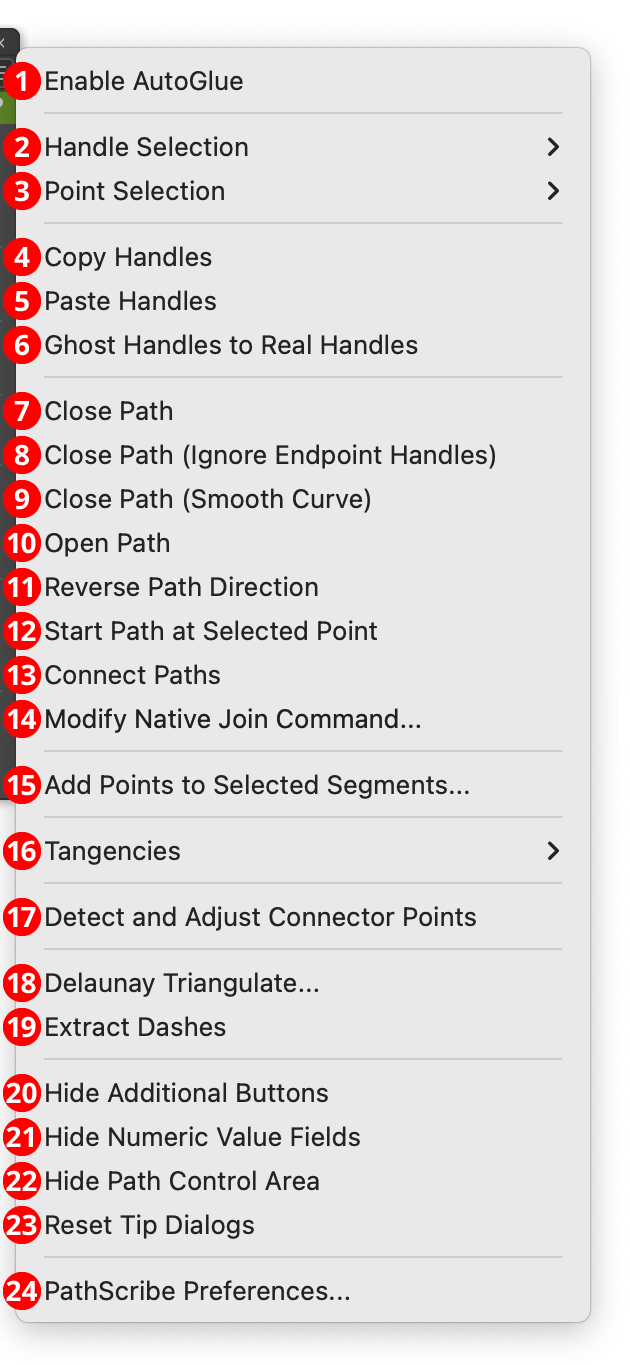
PathScribe Panel Flyout Menu
The PathScribe panel flyout menu and related submenus are shown here with all items enabled; in actual use, items which are not applicable in the current context would be disabled. Additionally, some of the menu items may change their wording slightly depending on context. For example, the Hide Additional Buttons menu item will say Show Additional Buttons if the buttons are already hidden.
1. Enable/Disable AutoGlue
AutoGlue is a feature of the PathScribe tool that enables anchor points (and/or handles) that lie directly on top of each other to be treated as if they were temporarily “glued” together, thereby allowing them to be moved together even if they aren’t all selected. The feature is disabled by default. When first enabled, a tip dialog with a short summary will be displayed.
Normally, dragging an anchor point without marquee-selecting multiple points will only affect the topmost path, even if other anchor points sit at the same position:

PathScribe Example Without AutoGlue Enabled
But when AutoGlue is enabled, all anchor points with the same coordinates will act as though they were “glued” together, and will move as one:

PathScribe Example With AutoGlue Enabled
AutoGlue also works on entire path segments: if two paths share a segment (both the anchor points at each end and their inward-facing handles, if any, all lie on top of each other), then editing the path segment (reshaping, dragging out or converting ghost handles, and adding or deleting points) with AutoGlue enabled will simultaneously edit the “glued” segments:

PathScribe AutoGlue Example Reshaping Segments
AutoGlue is especially useful when working with artwork created with generative AI, since this type of art is often composed of non-overlapping paths with common edges. A tolerance value, used to determine whether coordinates are considered identical, is specifiable in the PathScribe preferences.
2. Handle Selection submenu
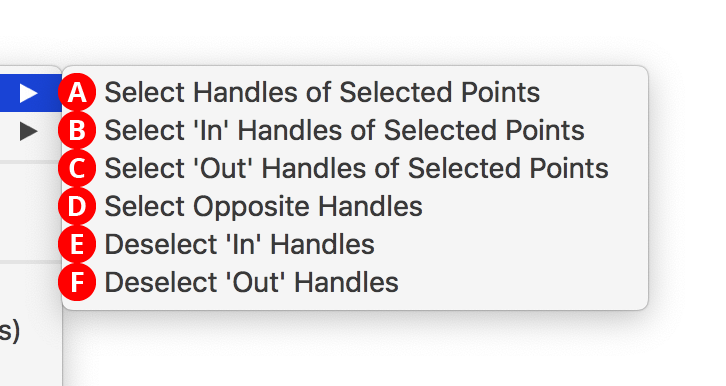
PathScribe Panel Flyout submenu
A. Select Handles of Selected Points
When there are one or more points selected, selects all of the handles on all of the selected points and enters Multi-Handle mode. The PathScribe tool will automatically be selected afterwards if it is not already so you can work with the selected handles.
Shift+Option/Alt-clicking on an empty area of the canvas with the PathScribe tool does the same thing as choosing Select Handles of Selected Points but is much easier.
B. Select ‘In’ Handles of Selected Points
C. Select ‘Out’ Handles of Selected Points
Same as A., but only selects handles of the specified type.

Select in and out handles PathScribe
D. Select Opposite Handles
[Enabled only in Multi-Handle mode] Selects an anchor point’s in handle if only the out handle is selected, and its out handles if only the in handle is selected. If both handles were originally selected, they both remain selected.
E. Deselect ‘In’ Handles
F. Deselect ‘Out’ Handles
[Enabled only in Multi-Handle mode] Removes all handles of the specified type from the handle selection.
3. Point Selection submenu
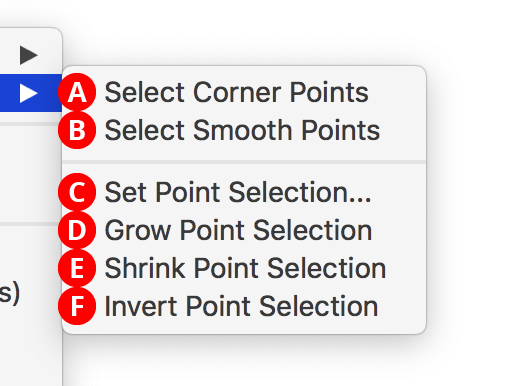
PathScribe point selection submenu
A. Select Corner Points
B. Select Smooth Points
Selects all anchor points of the specified type on all selected paths.
C. Set Point Selection...
Allows you to select points on selected paths by position, using the dialog that comes up:

Point Selection PathScribe Skip Steps
The “Initial Skip” value specifies the number of anchor points to leave unselected, starting at point 0 of the path. Thereafter, the selection pattern is specified by the “Select” and “Skip” values, which specify the number of points in a row to select followed by the number to leave unselected. As the values are changed, the points which will be selected are dynamically highlighted on the artboard using magenta dots:

Point Selection PathScribe Skip Steps
You can bypass the dialog and use the values from the previous application of Set Point Selection by holding down Shift while choosing the menu item. The Reset button changes Initial Skip to 0, Select to 1, and Skip to 1 (i.e., every other point starting with the first). Holding down Shift while clicking the Reset button does the same except the Initial Skip is set to 1.
D. Grow Point Selection
Grows the current point selection by selecting one additional anchor point on either side of all points which are already selected.

PathScribe Grow Point Selection
You can use the keypress assigned in the Keyboard Shortcuts dialog for “Decrease Diameter” (by default, the left bracket key – [) as a shortcut for growing the point selection.
E. Shrink Point Selection
Shrinks the current point selection by deselecting all anchor points which already have an unselected point on either side of them, or are on the end of an open path.
F. Invert Point Selection
Inverts the current point selection by switching unselected anchor points for selected points. Paths which were completely unselected to start remain unselected.
4. Copy Handles
Lets you copy the direction and length of a single handle, or, as long as they are the in and out handles of a single point, two handles. When both handles of a point are copied, the point type (corner or smooth) is also retained. The menu item is available when a single point is selected, or in Multi-Handle mode when one handle or the in and out handles of a single point are selected. The PathScribe tool does not need to be active when copying both handles from a single point. Copied handle and point type data is stored in an internal clipboard which is cleared only when Illustrator is quit.
5. Paste Handles
Lets you change both handles on any selected points (or specific, selected handles when in Multi-Handle mode) to match the handle(s) that were previously copied with Copy Handles. You can paste to multiple points on multiple paths, and the PathScribe tool does not need to be active. If a single handle was copied, then its data will be pasted to any selected handles, regardless of type (in or out), and any affected points will become corner points. If both handles of a single point were previously copied, then selected in handles will receive the copied in handle’s data, and selected out handles will receive the copied out handle’s data. If a point gets two new handles from two handles that were previously copied, then the previously-copied point type (smooth or corner) is also applied to it.
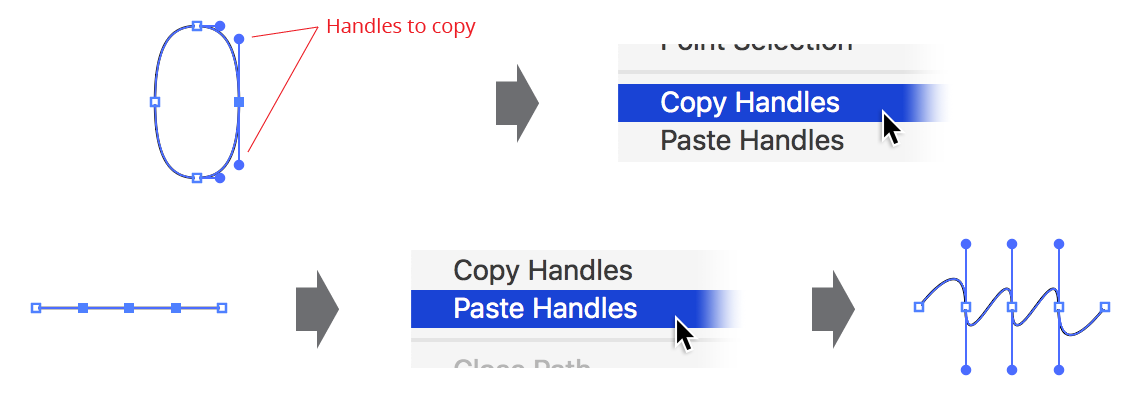
PathScribe copy paste handles
6. Ghost Handles to Real Handles
When one or more ghost handles are visible, converts them to real handles.
7. Close Path
8. Close Path (Ignore Endpoint Handles)
9. Close Path (Smooth Curve)
All these menu items close selected open paths; they differ in how handles for the new segment are created. Close Path honors existing handles; Close Path (Ignore Endpoint Handles) always results in a straight new segment without handles; Close Path (Smooth Curve) creates new handles for the segment such that it blends smoothly with the existing path segments:
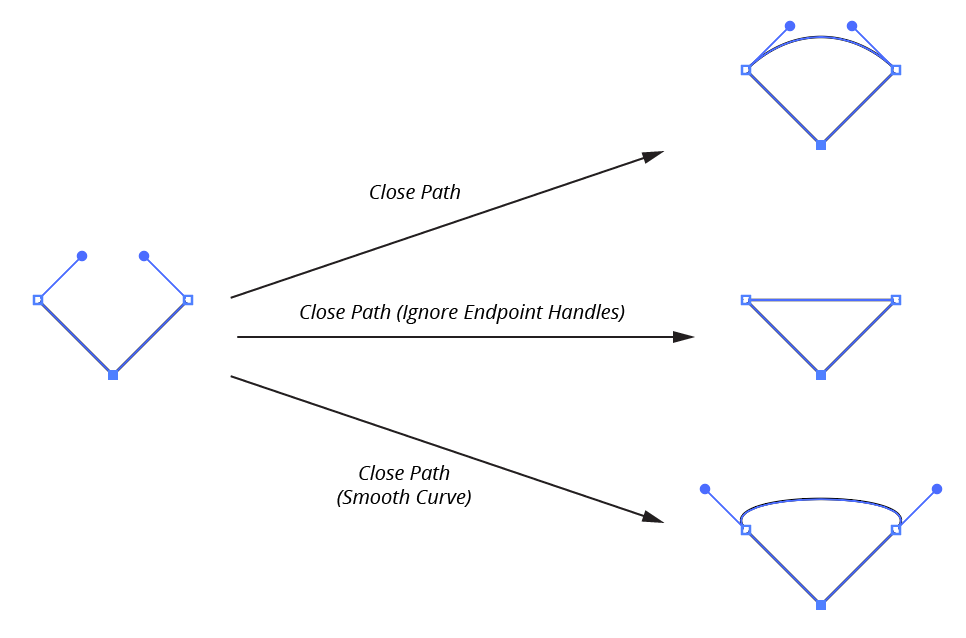
PathScribe Panel Flyout close path
10. Open Path
Converts all selected closed paths into open paths by removing the last segment (point count does not change). This can be useful for fixing paths that are simple two-point lines which have been inadvertently created or imported as closed paths.
11. Reverse Path Direction
Performs the identical function as the Reverse Path Button on the PathScribe panel, but is accessible even when the third row of panel buttons is hidden.
12. Start Path at Selected Point
Available when the selection consists of at least one closed path with exactly one selected point. Forces the closed path to begin at the selected point (it becomes “Point 0”). The change to the path is generally only visible when the path is stroked by a non-uniform brush, or has an arrowhead:

PathScribe Start Path at Selected Point
13. Connect Paths
Available when the selection consists of exactly two open paths, each with a single endpoint selected. Acts similarly to the native Join command, but instead of a straight joining segment, the joining segment will blend smoothly with the existing path segments:
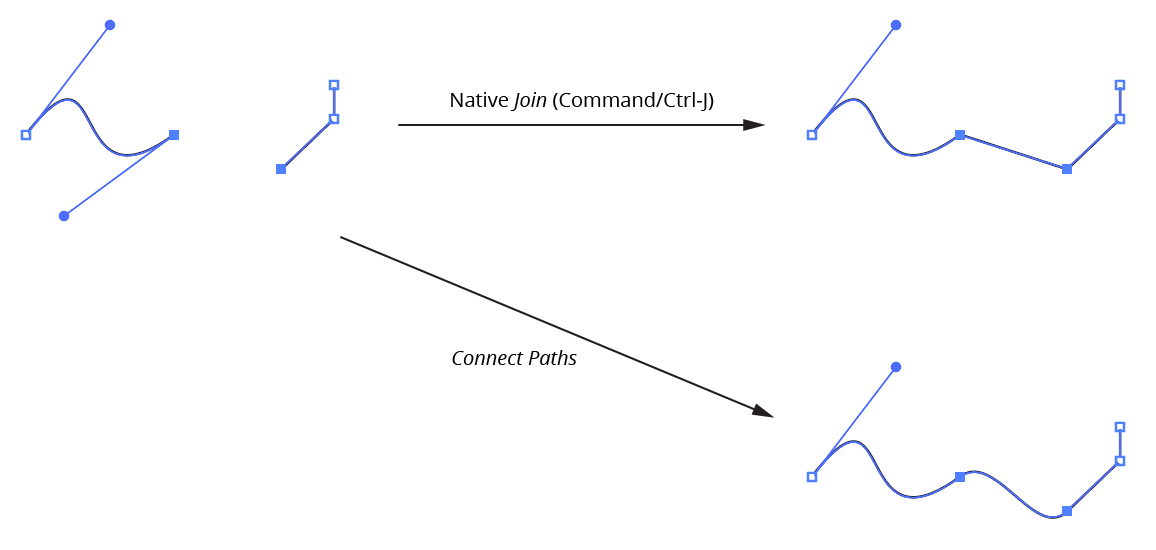
PathScribe Panels Connect Paths
14. Modify Native Join Command…
Allows the native Object > Path > Join menu command (typically called using the shortcut key Command/Ctrl-J) to join the selected paths with smoothly curved segments instead of the default straight segments. Choosing the PathScribe menu item will bring up a small dialog:
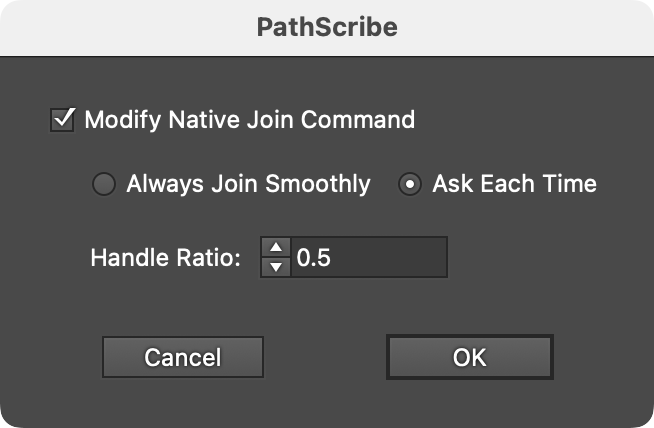
PathScribe Modify Native Join Dialog
Turning on the Modify Native Join Command setting will allow one of two methods to be used:
Always Join Smoothly: Whenever the Join command is used, the paths will automatically be joined smoothly with the originally-specified handle ratio. To join using straight segments, the PathScribe flyout menu item would have to be selected again to turn off or change the setting. Therefore, this setting is best used when you rarely want to join with straight segments, or need to adjust the handle ratio.
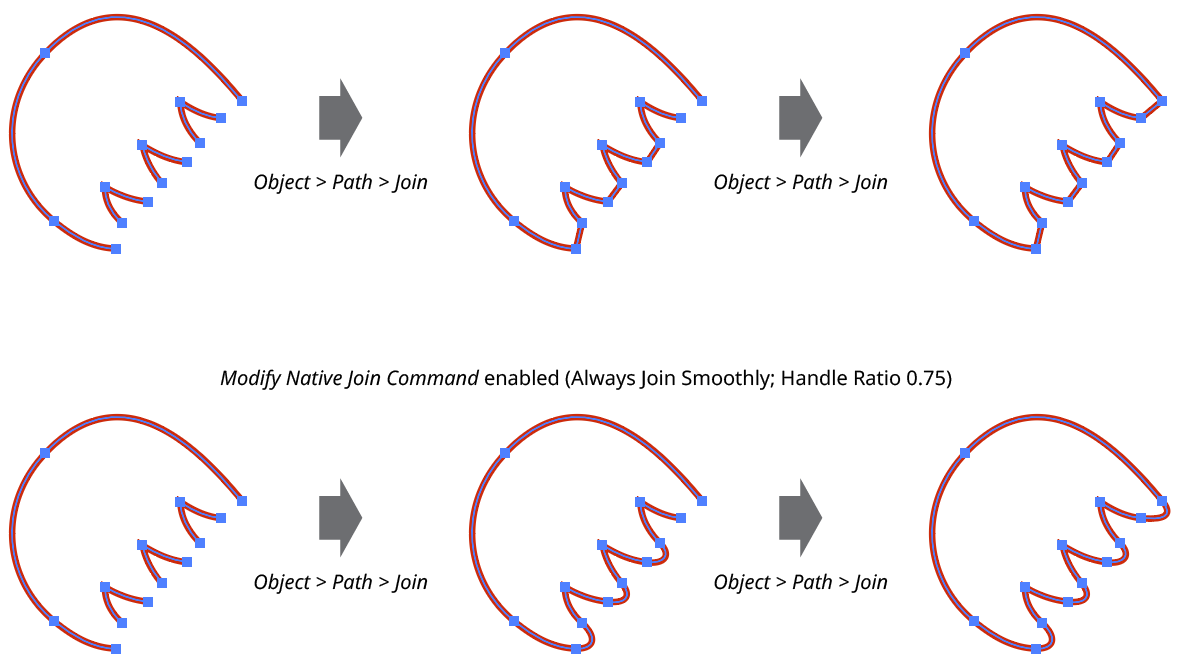
PathScribe Modify Native Join Command Example
Ask Each Time: Whenever the Join command is used, an additional dialog will come up immediately prior to its execution, allowing you to either join in the native way (straight segments), or with smooth curves. If the latter, the Handle Ratio can be changed as well (see below). The Join Type choice affects only that specific instance of the Join command, unless Always Use This Choice is enabled before the dialog is OK’d. In that case, the choice will be remembered and the dialog will not come up again unless the PathScribe flyout menu item is selected once again.
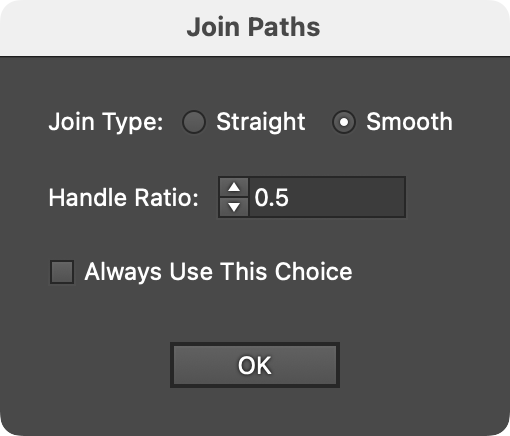
PathScribe Modify Native Join Ask Dialog
The Handle Ratio specifies the length of the automatically-generated handles, in relation to a default value. Higher ratio values will create longer handles, which make the joining curves “protrude” more. The ratio can be specified from 0.1 to 25.
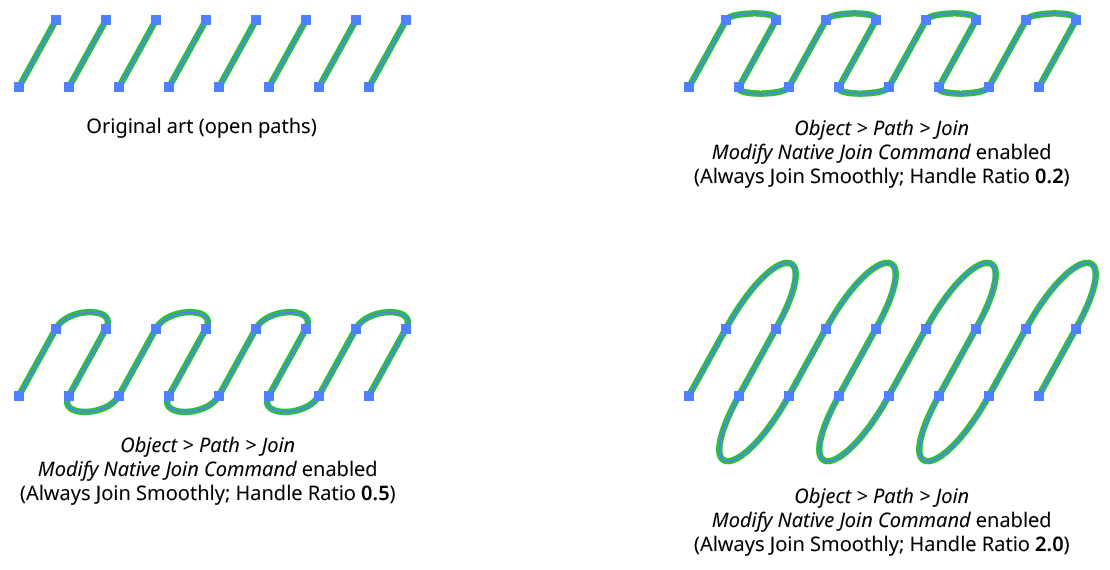
PathScribe Modify Native Join Command Handle Ratio
Note that the native Join command will not convert multiple open paths into a single closed path with a single use; it must be called twice to do this.
15. Add Points to Selected Segments...
Performs the identical function as the Add Points to Selected Segments Button on the PathScribe panel, but is accessible even when the third row of panel buttons is hidden.
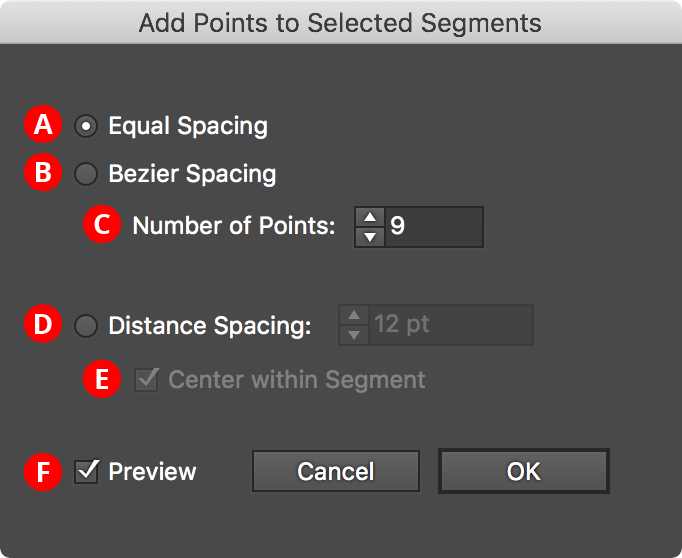
PathScribe Add points to selected segments
There are three different spacing methods you can use to add points. For the first two, Equal Spacing and Bezier Spacing, you specify the number of points to add to each selected segment. Equal Spacing creates equal distances between points, as measured along the path. Bezier Spacing places the points such that there are equal distances between t-values, which are a mathematical property of the cubic bezier curves with which Illustrator’s paths are constructed:

PathScribe Panel Add Point Equal Spacing
For Distance Spacing, you specify the distance between anchor points, as measured along the path. Since this distance will usually not exactly divide the total length of the segment, the “Center within Segment” option allows you to center the new points within each segment:
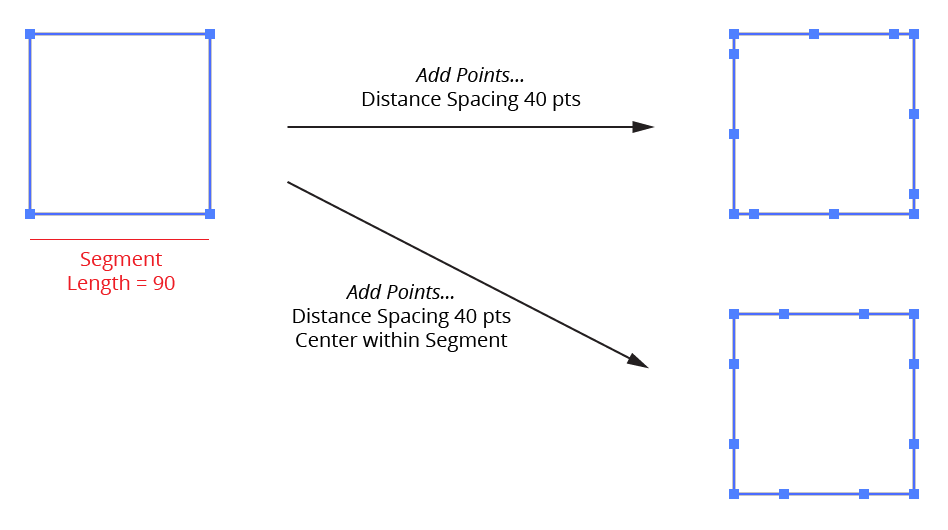
PathScribe Panel Add Points Distance Spacing
You can bypass the dialog and use the values from the previous application of Set Point Selection by holding down Shift while choosing the menu item.
16. Tangencies submenu
Tangencies are places along a path where the path’s direction (and therefore the direction of a line that is tangent to the path at that spot) is either vertical or horizontal (taking into account the general constrain angle). Certain drawing methods include the principle that anchor points along a curved path should be, whenever possible, located at these places of tangency.
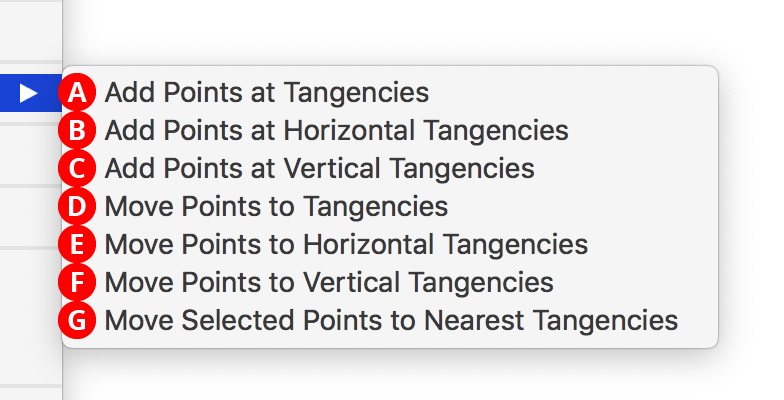
PathScribe Tangencies Flyout Submenu
A. Add Points at Tangencies
B. Add Points at Horizontal Tangencies
C. Add Points at Vertical Tangencies
These menu items add new anchor points, if needed, at places of tangency along all selected paths. Existing anchor points are not changed.

PathScribe Add points at tangencies flyout option
D. Move Points to Tangencies
E. Move Points to Horizontal Tangencies
F. Move Points to Vertical Tangencies
These menu items act similarly to their “Add Points...” counterparts, except that existing anchor points are removed after the tangent points are added if their removal does not alter the path shape appreciably.

Move points to tangencies PathScribe flyout option
G. Move Selected Points to Nearest Tangencies
While the previous items affect every anchor point on a path, this item only moves points which are selected to the nearest horizontal or vertical tangency (if possible).
17. Detect and Adjust Connector Points
Enabled when the Recognize Connector Points preference is enabled, this menu item scans any selected paths for potential connector points and, if found, adjusts their handles.
18. Delaunay Triangulate...
Brings up a dialog which lets you set parameters for creating a “Delaunay triangulation” (a network of triangles) from the selected artwork.
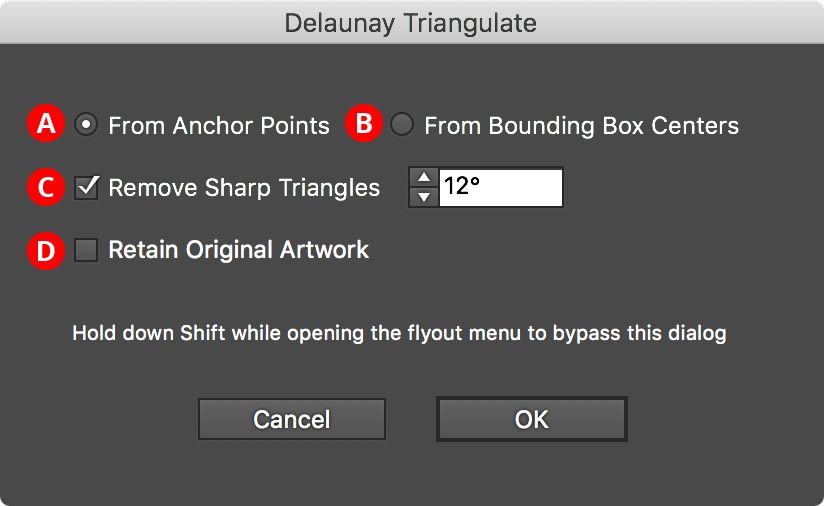
Delaunay Triangulate PathScribe
A. From Anchor Points
Triangles are created using anchor points on all selected paths.
B. From Bounding Box Centers
Triangles are created using the centers of the bounding boxes of all selected art (groups are ignored).
This is useful when creating a triangulation from, say, an expanded Stipple live effect.
C. Remove Sharp Triangles
Delaunay triangulation can create sliver-like triangles that are often undesirable, so this setting lets you eliminate any triangles that have an angle smaller than the threshold value.
D. Retain Original Artwork
When enabled, the artwork used to create the triangles is left in place and the triangles (grouped) are placed above it.
When the Shift key is held down while choosing the menu item, the dialog will not be shown and parameter values that were previously in effect will be used.
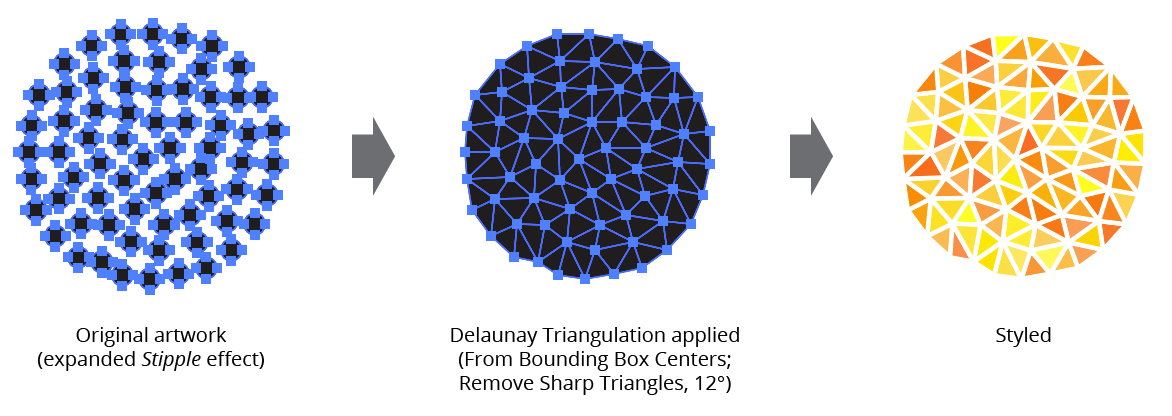
Delaunay Triangulate Points PathScribe
19. Extract Dashes
Converts a path with a dashed stroke into a compound path made up of separate, non-dashed subpaths.
This can be useful for giving the dashes different styles, for example:

PathScribe flyout menu extract dashes
20. Show/Hide Additional Buttons
Shows or hides the third row of buttons on the PathScribe panel. When hidden, most of the buttons’ functionality can still be accessed through the flyout menu commands.
21. Show/Hide Numeric Value Fields
Shows or hides the center section of the PathScribe panel which shows anchor point and handle coordinates.
22. Show/Hide Path Control Area
Shows or hides the bottom Path Control area of the PathScribe panel.
23. Reset Tip Dialogs
If the “Don’t show again” checkbox was used on any tip dialogs (such as the AutoGlue dialog that appears when the feature is enabled), this resets the dialogs so they are shown again.
24. PathScribe Preferences...
Brings up the Preferences dialog.
